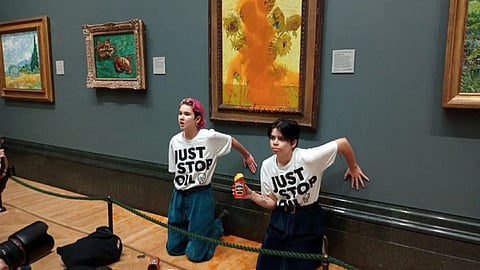

CHENNAI: What do da Vinci’s Mona Lisa, Vermeer’s Girl with a Pearl Earring, and Van Gogh’s Self Portrait in Saint Remy have in common? They are all masterpieces that have been vandalized – albeit unsuccessfully - by climate vigilantes. The objective was to draw the attention of world leaders and big corporations to the damage being done, thanks to human activity-led climate change. Such measures may be viewed as an overkill, but if news emerging from the CoP 27 or United Nations Climate Change Conference is to be believed, we might have to think twice.
The UN Secretary General Antonio Guterres said our planet is in big trouble. The World Meteorological Organisation warned last week that the planet’s warming weather and rising seas are getting worse and accelerating in a manner that hasn’t been seen before. As per the latest State of the Global Climate Report, sea level rise in the past decade is double of what it was in the 1990s. A flood in Pakistan wreaked damage in excess of $40 bn, killed 1,700 people and displaced 7.9 million people, as per World Bank estimates. China has seen its bountiful river Yangtze drying to its lowest level this August.
Such disasters are being experienced simultaneously in other parts of the world. Over 18 million people in East Africa are threatened by food insecurity owing to a four year long drought, while nations in the European Union are struggling with heat waves. The world’s ambition to decrease its reliance on fossil fuels has been hit by the Russian invasion of Ukraine. As a result, economies are reeling from high inflation, food shortages and energy crunch.
While rich nations like Germany, France and the UK are eyeing solar and wind energy as alternatives to petroleum and natural gas offered by Russia, not every nation in the global south has the bandwidth for speedy adoption of renewables. Several western media firms had targeted India and China, branding them as the biggest polluters in the world, and even going so far as to shame them, as the leaders of the two countries have so far been a no-show at CoP 27. This is also the case with the US President Biden who was stuck in the US in the wake of the midterm elections. As always, nations who had trailed behind in industrialisation and contributed to a much lower share of greenhouse gases as compared to their highly industrialised counterparts, are the ones bearing the brunt of climate change. Pulling up countries like India is going after low hanging fruit, especially when the nation is seriously pursuing its goals of attaining energy sufficiency via non-fossil fuels.
At CoP 21, as part of our Nationally Determined Contributions (NDCs), India had committed to achieve 40% of its installed electricity capacity from non-fossil energy sources by 2030, as per the Ministry of New and Renewable Energy. We had already achieved this target in November 2021 itself. What has not been fulfilled is the pledge made by developed nations who had promised emerging economies a sum of $100 bn every year to support climate action and offset the impact of global warming. That pledge is set to expire in 2025. If world leaders are going to harp on with the same blame game narrative, our collective aim of limiting global temperature rise to 2 degrees Celsius will remain a pipe dream. And we will have front row seats to the ongoing tragedies of climate change.
Visit news.dtnext.in to explore our interactive epaper!
Download the DT Next app for more exciting features!
Click here for iOS
Click here for Android